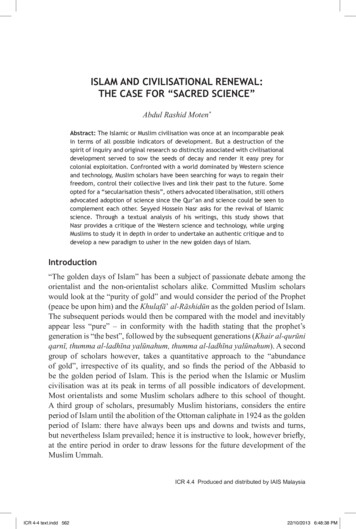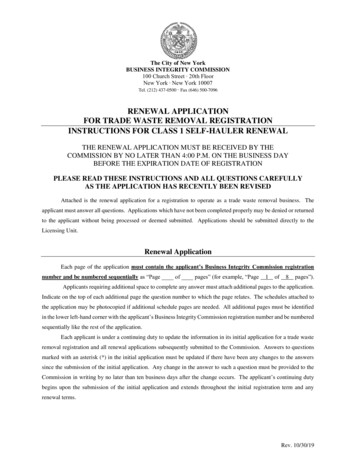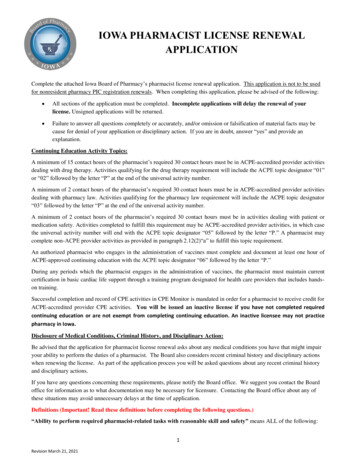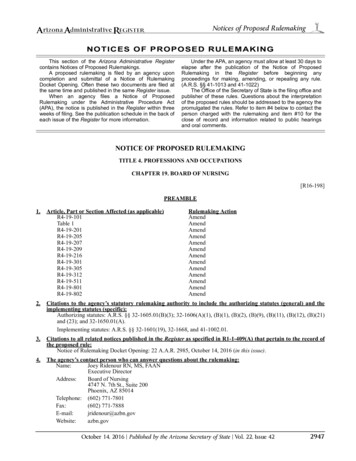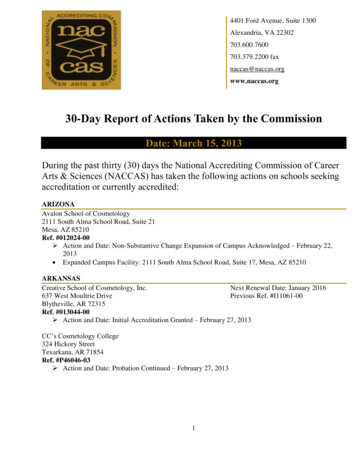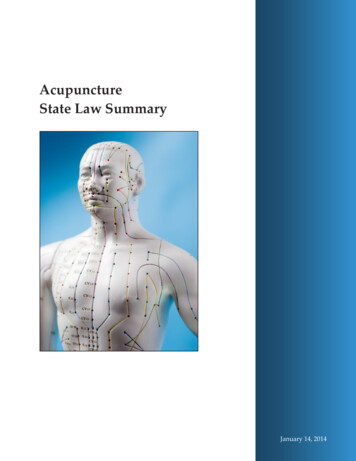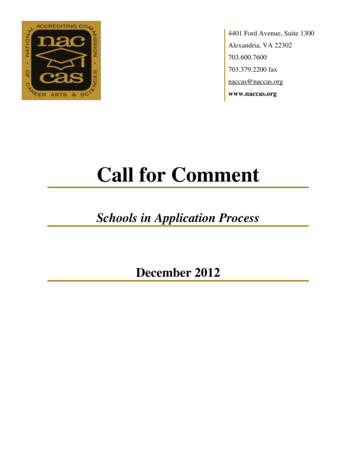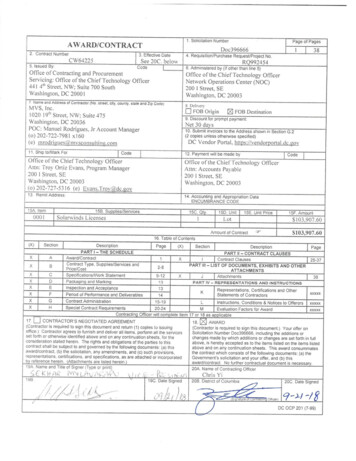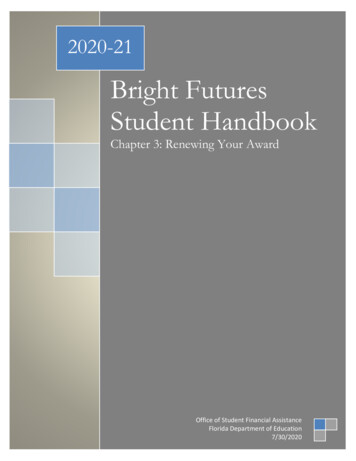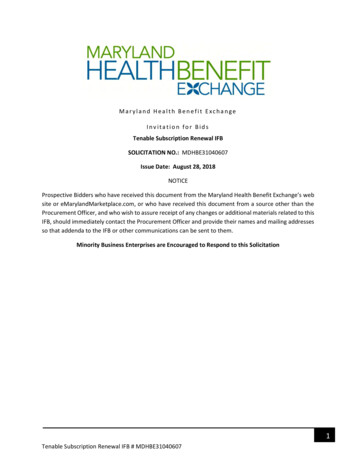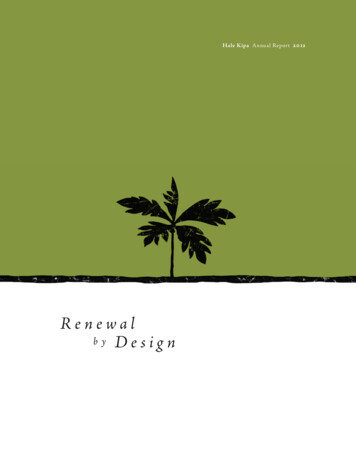
Transcription
Hale Kipa Annual Report 20 12Renewalby Design
Board of DirectorsExecutive StaffCapital Campaign CabinetLuke W.T. YehPunky Pletan-CrossJeannie HedbergChairCeoChairHeidi K. WildJaque Kelley-UyeokaMomi CazimeroVice ChairDeputy CeoVice ChairGreg J. SitarO u t r e ac h S e rv i c e sChris BenjaminT r e a su r e rMari VermeerScott W.H. SeuD e p u t y C EOP l ac e m e nt S e rv i c e sS e c r e ta ryDori TyauStacy EvensenD i r e ct o r o f H u m a nPa s t C h a i rResources and TrainingPaul A. SchraffTracy JanowiczPa s t C h a i rD i r e ct o r o f Q ua l it yBrian IsobeI m p r ov e m e nt/ Fac i l i t i e sPa s t C h a i rStacy EvensenHeidi A. CregorD i r e ct o r o f E d u c at i o n a l /Pa s t C h a i rVo c at i o n a l S e rv i c e sGalen K. HanedaSherri-Ann IhaMicheal MagaoayRona M. SuzukiSusan Y.M. UtsugiZadoc W. Brown, Jr.N e i g h b o r Is l a n d L i a is o nAndy LevinN e i g h b o r Is l a n d L i a is o n2HaleKipaVice ChairPip WhiteVice ChairRick ChingBrian IsobeH a l e K i pa B oa r d M e m b e rRichard ReeseLuke W.T. YehH a l e K i pa B oa r d c h a i r
Redrawingthe B a s e l i n eThere are two good times for an organization to redefine who they are: When they’ve changed. Andwhen the world around them has changed. A lot of both has happened around here in the last year.We have weathered sea-changes in the way government and the community has looked at social services in general, and at services for teens and young adults in particular.Nonetheless, the population that we have traditionally served is still out there, and they still needthe same kinds of services that we have provided throughout out our 42 year history. Though therapeutic groups homes are no longer a funding priority, for example, there are still youth that have theissue that those homes answered. Where are they going to get those services now?We are also facing new realities that demand new solutions for our clients, ones that we believe willhelp them get a toehold on a good life. These solutions are rooted in our understanding of what worksbest with young people, what resources are still available, and what the community will stand behind.In many ways, who we are is who we have always been: An organization dedicated to helping youngpeople through the most difficult times of their lives, to giving them the best chance for success asadults in an uncertain world. Dealing with at-risk adolescents, we will struggle for adequate resourcesin lean times, perhaps more than other social service programs. But the conscience of the communityin regards to youth services must be maintained.That’s our baseline.2 0 1 2 A n n ua lR e p o rt3
Punky Pletan-Cross President and Chief Executive OfficerOne of the hallmarks of a healthy social services agency is its stability, for that is whatits clients count on. But when everything is changing in the community, from expectations to funding, maintaining an even keel can get tough. Stability can feel like the abilityto stay on top of a rolling ball on uneven ground, something Hale Kipa has had amplechance to perfect over its long history and especially in recent years.It looks like we’re going to have more opportunities to practice. Economic and socialpolicy pressures have moved us away from one of our recent core lines of service – therapeutic residential homes. Many residential programs that have focused on the behavioralissues that youth at risk face as a result of their unique circumstances are today seen as outmoded treatmentmodels that the nation can no longer afford.But the need to prepare young people for life after youth services hasn’t gone away. Skills that are normally passed onin intact families are often lacking in our youth. If our programs don’t succeed in remediating and moderating theirbehavioral and emotional issues, they are at risk to be unsuccessful as young adults. We are much more likely to end upproviding other kinds of services to them: criminal, judicial, and correctional.Of course, nobody wants to see that happen. The community looks to organizations like Hale Kipa to find ways ofadapting, of changing our game plan so that our youth get the help they need. In the past year, that adaptation looks likea greater focus on academic and vocational education. We have expanded our use of the Ansell Casey independent livingskills curriculum and Kuder Career Planning tools to assess more of our youth. Our youth are benefitting from the skillswe are teaching them, and are being sent off into adulthood on a healthier trajectory.A plethora of educational alternatives being developed in the community may be evidence that the Department of Education is weaving the fabric of a better educational system for youth. But that’s mainstream. There will always be those youththat the DOE and other providers can’t or won’t focus on, youth that don’t fit the standard model, that won’t benefit fromthe new programs. Young people, in other words, that are the population that Hale Kipa has historically served.We are also looking at various forms of alternative education. Most of the youth that we work with are at tremendousrisk for homelessness. Without the education, skills, and training needed to get a good job, they are doomed to minimumwage jobs or unemployment and the emotional problems are going to come back. We need to find ways to fortify existing programs and initiate new ones, even as we continue to offer the human services that we have historically offered.Then there are a lot of youth in Hawai‘i that have never been touched by an organization like Hale Kipa, but who still fitthe profile of our kids. These youth have all the risk factors for future difficulty as young adults: chaotic families that areracked by substance abuse, domestic violence and criminal behavior. They are behaviorally challenged, bored in school,and unresponsive to authority. They don’t follow structure well, and have difficulty coping with trauma or the dysfunctionthey experience in their lives.They require an organization that has the capacity to understand their human service needs, not just their lack of life skills.They need an organization that provides alternative education and vocational training, sure, but in a way that assures thatthey see a future for themselves as successful adults. They need an agency that understands that most of the challengesthey face in traditional learning environments are often a result of their home environment.One thing is certain; we are not going back to where we were. The winds of social and public policy have changed dramatically and technologies have shifted. But neither have we any interest in being “just” an agency focused on vocational andeducational needs. We are a human service agency that will offer an array of educational vocational resources in supportof our human services. That, after all, is the core of our mission.4HaleKipa
Luke W.T. Yeh Chair, Board of DirectorsThe past fiscal year for Hale Kipa was like in some respects an unwanted sequel tothe prior one: a significant and further reduction in the agency’s core governmentcontract revenue base; a bottom line deficit; and additional cuts to programs, staffing and infrastructure.The effect of program cuts are difficult to measure in terms of the impact on the youthof Hawai‘i — young people who have benefited from the services that Hale Kipa haveprovided which are now less readily available. And while some see improvement in theeconomic environment and outlook, there does not appear to be such optimism for restoring funding for programs and services that Hale Kipa has had to reduce or eliminate. This is the harshreality that many providers in the human services arena have come to grips with (though having companyin this predicament does not provide a whole lot of consolation).In the midst of all this, two fundamental elements have not changed: a) the segment of our youth population in Hawai‘i who are at risk and require critical and specialized human services, and b) Hale Kipa’slong standing mission and commitment to helping those youth. These two pillars continue to serve as acompass and guide through this tumultuous period.But Hale Kipa’s energies and efforts have not solely been focused on fiscal survival. The organizationrecognizes that doing its best for Hawai‘i’s at-risk youth requires the ability to recognize and embracechanges to the environment. Hale Kipa must identify and pursue new areas of opportunity at the trifecta of demand, high impact and funding. The new initiative to developing alternative educational andvocational services is one area that Hale Kipa will pursue is pursuing, and will building momentum andprogress into this next year.To all of Hale Kipa’s supporters, please know that your efforts, actions and thoughts in whatever formand fashion are meaningful and needed, now more than ever. Financial support comes top of mind, andno doubt it has significant and immediate impact. But there is also great value from those who help togenerate awareness of the needs of Hawai‘i’s youth, attention to potential solutions, and support fromthose of influence and the community. The work that Hale Kipa does in helping Hawai‘i’s youth andcommunity cannot possibly go on without you.2 0 1 2 A n n ua lR e p o rt5
It ’s a Wr a pIn lean times, youth services need to think horizontally instead of vertically. They need to letgo of the model of one agency or organization providing services up and down the range ofneeds of each individual client, and think more about how the needs of the youth can be metby reaching outward to other organizations that specialize in that exact area.This approach, what professionals call “wraparound services,” puts the youth at the center,and fills in the picture with all the agencies that can provide for the youth’s needs. The roleof an organization like Hale Kipa is to manage the process, to properly assess the youth andto make sure the right services are brought to bear.In a way, it’s what Hale Kipa has been moving toward for a decade, with programs likethe Hawai‘i Advocate Program. Following a fair assessment of the youth’s needs, we findresources in the community that fill in the gaps, whether they are related to life skills, emotional issues or vocational education. What’s new is the recognition that this approach canhelp keep youth out of foster care and mental health in-patient facilities.The “wraparound” model is even more appropriate when you consider new demands onsocial services to produce more concrete results from the programs that service youth. Thecommunity wants to know that the resources they put into youth services are going to payoff, that the lessons stick, that youth who “age out” of costly programs are going to entersociety as law abiding, productive adults.These concerns are fueled by studies like those of Casey Family Programs that found that25% of alumni of foster care programs around the nation suffer from post-traumatic stressdisorder, a similar percentage to that of U.S. War veterans. A scant 3% of these young adultshad completed a college degree. Nearly half of them don’t have jobs at age 21.In Hawai‘i, a growing percentage of the youth who are emancipated from the child welfaresystem at age 18 are becoming homeless. Once homeless, the chances youth have for gettinga good job or safe home decrease dramatically. It is a vicious cycle that youth services professionals across the country want to break. It’s why in Hawaii the Department of HumanServices is looking hard at extending support for foster care youth to age 21, despite thepolitical and funding hurdles such programming might require.The wraparound model is especially effective at handling this population. When the primaryagency takes the time to understand why these youth are more likely to encounter difficulty inmaking their way in the world as adults, they can be more precise in directing the right services.Once agencies get really good at networking and making speedy referrals, wraparound isgoing to be good for youth. In most cases, the youth is better off by avoiding residential programs at all — as long as they are getting the attention and structure they need. Agencieslike Hale Kipa succeed in the new paradigm by fairly assessing the youth that we see and byfinding the right programs to ensure their success as young adults.6HaleKipa
Assessing And RespondingPrograms are developed for large populations of youth. But people are individuals. One youngadult may need to learn a set of skills that another has down. To say we care about the successof each young adult as an individual is one thing. To demonstrate that fact in quite another.One way to show our commitment to their success is with individual assessment. Today,there are tools that make the process of assessment easier, and with a higher degree of relevance, than ever before. Casey Family Programs has established Casey Life Skills Assessment (CLSA) for use by public and private child-serving agencies and organizations acrossthe nation. The online assessment helps caseworkers and youth determine where the youthis in regard to key life skills areas like maintaining healthy relationships, work and studyhabits — even mundane skills like cooking and paying bills.While the site’s primary audience is youth in foster care and their case workers, it it’s alsobeing used with great results for youth involved in juvenile justice facilities, employmentcenters, homeless shelters and school systems. Other tools like the commercially availableKuder Career Planning System offer comprehensive solutions to help career planners of allages identify their interests, explore their options, and plan for career success.Once the assessment has been made, program leaders or social workers can focus on theareas that the individual is most lacking in. Bringing up the bottom can be key to keepinga young adult’s head above water. Knowing what’s out there and matching programs withassessed needs is at the very core of the wraparound philosophy.Life SkillsIn normal, intact families where adolescents grow up with solid parent relationships, lifeskills are passed on as a matter of course. Without healthy family structures, youth maynever get a chance to learn basic survival techniques for the modern world — money management, health and hygiene, job skills, basic social interaction, etc. If youth services agencies are not successful in teaching these skills, if youth enter society lacking the requisiteeducation or training to be gainfully employed, many will be unsuccessful as young adults.Agencies that traditionally focused on the emotional and mental health of youth are, as amatter of necessity, seeing this issue in a new way. For the last few decades, their philosophyhas been to remediate the core issues that brought young people in the doors. The thoughtwas that, once emotionally grounded, the youth would be able to learn much of what theyneed through our programs and on their own.But new economic realities are eliminating many high-end (read “expensive”) therapeuticprograms. It’s a cut-to-the-chase mentality in human services: teach the client what he orshe needs to survive, to be able to find living wage jobs. Moreover, even the best work in atherapeutic context can be undone by the grim realities of a minimum wage job, unemployment or poverty. Full participation in society requires that young adults have the capacity tosupport themselves and build healthy families.Fortunately, of all things to teach a young person in the throes of adolescent crisis, life skills2 0 1 2 A n n ua lR e p o rt7
may be the easiest. The youth often respond well to structure, having suffered from a lackof it in childhood. The challenge can be finding out what the youth needs to learn, and howbest they can be taught.Alternative EducationOther initiatives, including one by the National Youth Law Center (NYLC), have beenpushing hard to assure that youth in foster care receive adequate and appropriate educational services. The NYLC has found that 75% of youth in foster care are at least one grade levelbehind, and foster children are twice as likely to drop out of school as their peers. Oftentimes the structure and constancy of school can be the most grounding aspect of a foster orshelter youth’s life.The NYLC’s Foster Youth Education Initiative (FosterEd) aims to improve foster youth’soutcomes by ensuring foster children have educational champions supporting their successin school. Education specialists provide family case managers, teachers, school administrators, foster parents, biological parents, relative caregivers and others the skills and knowledge to identify educational strengths and ensure educational needs are met. The projectensures every foster child has an education case plan, and that these plans are implemented.One way to ensure educational stability is to insist that every youth in foster care have theright to continue to attend school in their home community, an idea recently proposed on anational level by U.S. Senator Al Franken of Minnesota. In Hawai‘i, the DHS is thinkingalong the same lines, to make it a priority that youth continue to attend their home schooleven while in emergency shelter placement such as Hale Kipa’s Kamala Homes.Certainly, to deal with the problem, we must start by securing a place in our society for theso-called “opportunity youth,” the population of 16 to 24 year olds that are neither in schoolnor employed. Nationally, that category is a whopping 17% of 16 to 24 year olds. When theyfail in school or in the workplace, we all lose.One way to keep youth moving forward is to offer competency-based education, which isbased on competency and proficiency, not grade or grade level. Essentially, when the studentmasters the body of material that is necessary to move to the next body of material, theymove on. When they finish mastering the requisite body of material that allows them tograduate, they do. (See sidebar: COMPETENCY-BASED CURRICULUM)For Hale Kipa, hiring a full time education developer and teacher signals the agency’s appreciation of the value in these approaches. Hale Kipa is looking at several alternative modelsof education, including competency-based curricula, that may be more appropriate for theirpopulation, and is beginning to offer remedial training for youth in some programs. In thespirit of wraparound services, Hale Kipa is also building relationships with other providersof alternative education in order to ensure our youth have access to all available solutions.8HaleKipa
Juvenile JusticeA parallel trend in improving outcomes for youth is in juvenile justice reform. Exemplifiedby the Casey Foundation’s Juvenile Detention Alternative Initiative (JDAI), the theoryis that keeping youth out of detention is key to preventing long term association with thejustice system. Youth that are incarcerated today, studies show, are more likely to becometomorrow’s career criminals.At its essence, the purpose of the JDAI is to demonstrate that local jurisdictions can safelyreduce their reliance on secure detention — and improve the lives of youth in the process.The Initiative wants to eliminate the inappropriate or unnecessary use of secure detentionof youth; to minimize re-arrest and failure-to-appear rates pending adjudication; to ensureappropriate conditions of confinement in secure facilities when detention is necessary; andto redirect public finances to sustain successful reforms.Key to the success of programs like JDAI is the collaboration between the juvenile justiceagencies, other governmental entities, and community organizations. Without collaboration, even well designed reforms are likely to flounder or be subverted. It is not enough forcommunity leaders to agree that our youth deserve every opportunity to succeed. We haveto take specific actions to ensure they get these opportunities.As hoped, this initiative has proven to be a catalyst in bringing state and private agenciestogether. The community has found that when everyone agrees that detention should be thelast resort, then they work hard to make diversion programs work together to keep youthin the community. It is the very essence of the wraparound paradigm. Hale Kipa has beenworking hard to foster this progressive evolution of juvenile justice through its involvementin high level decision making and through day-to-day application of the wraparound process.Trauma Informed CareAs youth service agencies respond to the mandate of their communities with greater emphasis on life skills and vocational training, they must also follow the most current thinkingabout the emotional state of youth at risk. Funding for therapeutic programs may wane, butthe kinds of environments that cause long lasting damage to young people are not disappearing. On the contrary, the economic forces that cause cutbacks in social services budgetsalso exacerbate the breakdown of healthy families.This sensitivity to youth who have suffered in dysfunctional families is being reexaminedin the light of “trauma-informed care.” The idea is that youth seeking public behavioralhealth services (and many other public services, such as homeless and domestic violenceservices), have histories of physical and sexual abuse and other types of trauma-inducingexperiences. These experiences often lead to mental health and other disorders such aschronic health conditions, substance abuse, eating disorders, as well as contact with thecriminal justice system.For a human service program to become trauma-informed, every part of its organization,management, and service delivery system must be assessed and modified to reflect a basic2 0 1 2 A n n ua lR e p o rt9
understanding of how trauma affects the life of their clients. Trauma-informed organizations, programs, and services understand the vulnerabilities or triggers of trauma survivorsthat traditional service delivery approaches may exacerbate, so that these services andprograms can be more supportive and effective.Hale Kipa’s commitment to trauma informed care involves training the entire organizationin the Risking Connection protocol and ensuring programs are aligned with the traumainformed approach. In fact, trauma has become the underlying conceptual framework forthe agency’s work in every area, and will certainly be a key consideration in the developmentof new programs like educational vocational services.Remembering FelixIt has been a generation since the Felix Decree in Hawai‘i proved that government is requiredby law to provide mental health, special education and other services to children with learningdisabilities. The U.S. District Court ruled that Hawai‘i would need to provide the services thatthe law required. Hale Kipa was one of the first responders to the Court’s decree, creating anumber of community-based programs to answer these needs — programs like TherapeuticFoster Homes and Therapeutic Group Homes — that gave youth a chance to receive services inthe least restrictive setting. The result was better outcomes for children than institutional ones.Remembering that ruling is a good idea today.As government human services departments retrench and program priorities change, werun the risk of falling afoul of a) Felix, and b) our responsibility to young members of societythat need our help. It can no longer be the case that we didn’t know we had to provide thesekinds of services. Now that we have recognized the parity between behavioral health andprimary care health services, we have to focus on ways to provide behavioral health — evenwhen budgets strain.We also know now that the wraparound approach works to focus services on youth, evenwhen less resources are available. Though there has been a dramatic reduction in residentialand institutional services, there has been a corresponding increase in outreach and outpatient services. As long as we keep behavioral health considerations at the core of everyeducational vocational initiative, every juvenile justice initiative, and all our thinking abouttrauma-informed care, we can answer the needs of our youth.The issues remain. Our responsibilities remain. The choice now is how to go about making it all work.10HaleKipa
Compete nc y-BasedCur r iculumTraditional schools measure student progress in terms of course credit hours. When youfinish — and pass — the course, you move on. Cool. But for students who work in different ways and at different paces, that formula can spell failure. They might be just as bright,just as motivated as the ones graduating, but cannot organize themselves for success.That is the thought behind schools like Boston Day and Evening Academy (BDEA) inRoxbury, Massachusetts, that use a curriculum in which student progress is based ondemonstration of competency through a variety of assessments. Their curriculum is madeup of over 300 benchmarks in humanities, math, science, and technology that measure thecompetence of each individual. The student moves on when he or she achieves the knowledge and skills that every high school graduate should possess in that area.Students enter BDEA with competencies they’ve learned from their previous schools. Afteran initial assessment, students’ competencies are recorded in to a database that they canaccess, so they know exactly what credit toward competency they have already earned, andwhat they still need to earn before graduating. Students are assessed at the end of eachtrimester through oral and written exams, portfolio presentations, and experiential projects.After students have demonstrated all competencies, they complete a “capstone” project, whichthey present to a panel of faculty, administration, and community members.Because graduation is not dependent on a fixed schedule of course work, schools likeBDEA typically hold several graduations per year. And part of the program is the creationof a post-graduate plan tailored to each student’s goals and interests which may includevocational training programs, job placement or internships, and/or college. Students notonly get the skills they need, they get launched in a positive direction after school.The biggest difference in competency-based schools is that every student can succeed. Infact, because success is measured individually, if the student is given the proper motivation,it is hard not to succeed. By meeting each student wherever they are in their education, andusing rigorous, experiential academics blended with social support and community building, students become confident, independent learners and creative thinkers.This approach to high school and vocation education especially suits Hale Kipa’s population of youth. It acknowledges that people learn at different paces and that grade level isn’tnecessarily a useful structure to measure progress.2 0 1 2 A n n ua lR e p o rt11
Prog ramsand S e r v i c e sIn 2007, Hale Kipa was a major player inplacement services in Hawai‘i. 5 years andmillions in budget cuts later, that picturehas changed dramatically. Although fostercare bed inventory is up (to 22 undercontract at last count), and we have 16emergency shelter beds as of January2013, a number of residential programshave closed altogether.Following the nationwide trend, human services in Hawai‘i have cut back on “high end”residential services — those that providetherapeutic services. The goal today is tobring youth home, wrap them in their owncommunities and to provide support without additional out-of-home placement.But while the recent major cuts to HaleKipa as an agency were in therapeuticresidential services, the work we do inour foster care programs is still stronglyinfluenced by our expertise in therapeuticapproaches. That goes as well for the workwe do at the youth correctional facility andthrough our Intensive In-Home Program.12HaleKipaIntervention & OutreachIntensive-In Home Services: Provides clinical therapy and services to families and youth in theirhomes, with the goal of strengthening families.Ka‘i Like Program (Intensive Monitoring):Provides support services to to youth involved in thejuvenile justice system.Pregnancy Prevention Services: Providespregnancy prevention curriculum to schools.Sexual Exploitation Prevention Program:Interactive video presentation delivered to schools andcommunity groups to inform and teach youth to identify, avoid and prevent sexual exploitation.Evening Counseling Program: Diversionprogram that provides counseling and linkages to community resources for youth who have been arrested.Hawai‘i Advocate Program: Statewideprogram that provides strength-based, wrap-aroundservices to youth in the Hawaii Youth CorrectionalFacility (HYCF) and to youth and families to assistthe re-integration of previously incarcerated youth intothe community upon their release from HYCF. Alsoassists youth in foster care stabilize in their homes.Ho‘okala-Attendant Care Program: Providesdiversion (intake and assessment) for youthful status offenders and non-violent lawbreakers, with 24-hour accessto immediate crisis intervention and attendant care.
Kauai Underage Drinking PreventionProgram: Aimed at services to help youth avoidhigh-risk behavior. (Ended 2012)coordinates with the Kamala Home Program to provideemergency foster home placement services for abusedand / or neglected youth between 10 and 17 years of age.Independent Living Program (ILP):Provides specific outreach and skill building servicesfor youth in and or transitioning out of foster careinto adulthood.Foster CareCommunity-based Outreach and Advocacy Program (CBOA): Outreach programfocused on providing case management and community linkages for youth to prevent initial or furtherinvolvement with child welfare or juvenile justice.Foster Homes Program: Longer termplacements with individual Hanai-short-termplacements for youth needing foster care and familytherapy. (Ended Oct. 2011)Youth Outreach (YO!): Collaborative progra
a greater focus on academic and vocational education. We have expanded our use of the Ansell Casey independent living skills curriculum and Kuder Career planning tools to assess more of our youth. our youth are benefitting from the skills we are teaching them, and are
